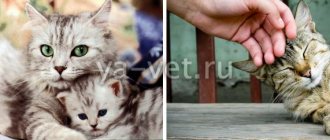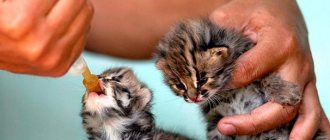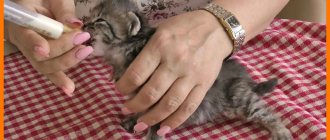British breed cats have a problematic character, so during puberty and preparation for mating, owners should pay special attention to them. But even after the female has become pregnant, it is too early to calm down, because in the process of bearing offspring and giving birth she may have difficulties.
Information about the features of this period will help the owner of a British cat to recognize the approaching birth and provide her with timely assistance.
How long does pregnancy last in British breed cats?
In British cats, pregnancy lasts approximately 65 days. But its duration also depends on the following circumstances:
- Weight. How long pregnant British cats walk depends on the size of the animal. Small females have a shorter period of bearing kittens than larger females.
- The gestation period is significantly shortened if the cat gives birth after her first heat. Usually it is up to 50 days. Cubs are born dead or with impaired vital functions.
- The first time pregnant British cats carry 1-3 cubs, they walk for about 60-65 days.
- Bearing a large number of kittens in a middle-aged British woman ends with delivery on the 58th day after fertilization (plus/minus 3 days).
What is not allowed in an “interesting position”?
The owner of a British cat expecting the birth of kittens should avoid the following:
- Treat her with any medications without first consulting a veterinarian.
- Overfeed your pet, as excess weight can cause complications during childbirth.
- Ignore health problems, especially high temperature, loose stools, vaginal discharge with an unusual smell and color. If any alarming symptoms appear, it is necessary to show the British woman to a specialist.
- Allow actions that can frighten the cat and make it nervous (too active games, listening to loud music, etc.)
Preparing a cat for pregnancy
A pregnant cat can independently find a place for future birth. This is one of the most important points when preparing to bear kittens. The owner must take care of arranging such a secluded corner in advance, because it is unknown how long a pregnant British cat will walk. You need to find a suitable box, a cardboard lid and warm, soft fabrics. The cover is needed in case the female does not allow anyone near her during childbirth.
The owner will be able to observe the process by lifting it. If assistance is required, the owner will be able to provide it in a timely manner. So that the woman in labor can freely leave the house, a passage should be cut. The bottom of the box should be covered with a soft diaper and covered with a disposable napkin.
A British cat can find a new, more convenient place to give birth at any time. Then you will have to urgently arrange the selected corner.
Postpartum rehabilitation
Let us dwell in more detail on the moment when the cat has already given birth, but for some reason cannot take care of the kittens, the owner must do the following:
- clean the kitten from postpartum film;
- place the kitten next to the mother;
- if necessary, carefully trim the umbilical cord at a distance of 4-5 centimeters from the navel;
- If necessary, wipe the kitten with a dry towel.
If the kitten does not move, you should carefully take it into your palm and shake it several times. Perhaps the mouth and lungs are filled with birth fluid. If this is the first kitten, you can put it aside on a dry diaper to protect it from the contractions of the British cat. The interval between the birth of kittens ranges from 10 minutes to an hour.
When the birth is completed, the family should be placed in a specially prepared place or left in a box. Provide food and water to help the cat recover after giving birth. A British cat may have discharge for several days. As a rule, this is a phenomenon of one or two days. If the process is delayed, you should consult a doctor.
For diarrhea, you should feed with rice water and boiled water. Oatmeal and warm milk will help with constipation. Close attention, affection and understanding will help significantly ease the birth of a British cat and avoid any negative consequences. For example, a miscarriage, which can lead not only to the loss of offspring, but also to surgical intervention.
Useful materials:
- Cutaneous horn General description of the disease Cutaneous horn on the forehead or face (ICD 10 code - L57.0) -...
- The cat has cancer Stages of mammary gland cancer in cats Like in humans, cat mammary cancer has ...
- Itching and odorless discharge Main causesBefore considering the factors that provoke the appearance of discharge that has a sour odor, it is necessary to immediately note...
- Normal temperature in animals Normal temperature in different types of animals Veterinary services Day hospital for animals Veterinary certificates Vaccination…
How to detect early pregnancy in a cat
Mating of a British cat does not always end with fertilization. To determine pregnancy in the early stages, you should be aware of some changes in the behavior, appearance and physiology of your pet.
In the first days, it is very difficult to determine a cat’s pregnancy. Minor changes do not provide an absolute guarantee that fertilization has occurred. Signs of pregnancy may include:
- Passive behavior. If a cat is very active in everyday life, then during pregnancy she will become calmer and sleepier. This occurs due to changes in hormonal levels.
- Early cessation of estrus, as fertilization can help reduce the duration of the phase.
- Increased nipple pigmentation. Hormones contribute to color saturation, but this is difficult to detect in the early days of pregnancy.
- Poor appetite may indicate fertilization. This is due to the fact that the cat experiences nausea a few days after mating. The symptom may also be due to the presence of diseases.
Note! Obvious signs of pregnancy in a British cat are observed 28 days after mating. The animal stops estrus, the nipples swell, and the enlarged belly becomes noticeable.
Medical tests can detect pregnancy from the 20th day after mating. Ultrasound gives an absolutely accurate result. Tests are carried out by determining the presence of relaxin in the blood, which is secreted by the placenta.
What does the diet look like during pregnancy?
Nutrition is an important part of your pet's life, especially in this position. Therefore, you need to familiarize yourself in advance with the basic principles that you need to know and follow when feeding. After all, pregnancy in a British cat can have complications due to poor nutrition. Therefore, you need to add to your diet:
- cereals and raw vegetables (carrots, cabbage), which can be discreetly mixed with your pet’s favorite food;
- It is important to give dairy products at the end of pregnancy because of the large amount of calcium they contain, which is necessary to strengthen the bones of kittens;
- boiled cartilage, thanks to which your British pet will receive a significant amount of vitamin D;
- In addition, you need to give other vitamins, especially groups A and B.
© shutterstock
Nuances and possible complications
The process of bearing offspring in a cat can occur with certain complications. It depends on how long a British woman is pregnant. To provide timely assistance, you need to carefully monitor her condition and regularly show the female to the veterinarian.
False pregnancy
Mating can lead to a false pregnancy, when fertilization has not occurred, but its signs are present. At the same time, progesterone is released in large quantities and the cat’s sensations are similar to those experienced by the animal during real pregnancy.
Symptoms can be present for 50 days and often lead to disruption of the pet’s nervous and psychological state. The following factors lead to disruption of the functionality of the reproductive system:
- hidden infectious diseases;
- congenital pathologies;
- staying close to cats that bear offspring;
- hormonal imbalances;
- mating with a sterilized cat.
Frozen pregnancy
Fetal freezing can occur in the first or early second month of pregnancy. At the same time, an already plump cat loses weight sharply, and the nipples do not change color. It is possible that it reaches birth, since not all kittens may die. Fetal freezing can only be detected using ultrasound.
Each fetus in a cat is in a separate bladder. If it dies, pus accumulates inside. The membrane may be damaged, then the contents of the bladder enter the uterus. The animal's condition deteriorates sharply and the temperature rises. In this case, only emergency medical intervention can save the female’s life.
Signs of a frozen pregnancy in a British woman:
- poor appetite;
- unnaturally swollen belly;
- constant feeling of thirst;
- copious discharge;
- anxiety, aggressiveness of the animal.
Important! The discharge may have a strong odor, be cloudy, or be bloody. They can be seen on the bedding or floor. The female licks her belly often and for a long time.
Superfetation
Superfetation occurs if a British cat goes into estrus while pregnant. Mating during this period can lead to new fertilization. As a result, the female will bear kittens with a difference in intrauterine age of up to 6 weeks.
What are the dangers of early pregnancy?
Fertilization in British women is possible already during the first estrus, which begins at 6-8 months. This determines how long the pregnancy of a British breed cat will last. The process expresses the body’s readiness for fertilization, the maturity of the reproductive system for conception and childbirth.
But in the first year after the start of estrus, experts do not recommend mating animals. At this time, there is a high probability of complications during the period of gestation and birth of sick kittens.
Final stage
At the beginning of the 7th week, the pregnancy of a pet of the British breed has some peculiarities. In particular, you can feel the babies’ heads well and feel their movements. The cat's large size does not allow it to walk quickly , so it moves very slowly. The behavior of the British pet is also changing, which is expressed in greater attachment to its owner, the so-called “following.”
A few days before giving birth, anxiety appears in the animal's character, and the search for a place to give birth begins. Basically, it should be a secluded and cozy corner.
Most owners of British cats take a crate or box in which they need to create a place for small kittens and their mother.
A necessary point in this period of pregnancy is radiography and ultrasound. The purpose of this procedure is to study information about the number of fetuses and their placement in the uterus. And if some kittens are in the wrong position, then this will need to be taken into account during childbirth.
Features of the first pregnancy
The first pregnancy for a British woman is a difficult and responsible period. The owner needs to give the cat a lot of attention and time. She needs proper nutrition, regular check-ups and a calm lifestyle.
It is difficult to determine the first pregnancy of a British woman. The main symptom is swollen, bright pink nipples. In a nulliparous cat, they are hidden under a layer of fur, and during pregnancy they increase. This happens later in the first pregnancy than in subsequent ones.
The first birth may take longer than usual. Their duration depends on how many kittens the British cat bears. Usually the first offspring is 1-3 babies. In subsequent pregnancies, the number of fetuses is greater.
Signs of false pregnancy
False pregnancy (graviditas spuria) in cats results from a mating remaining sterile when the eggs are not fertilized despite normal ovulation. This occurs either when there are problems with the quality of the cat’s seminal fluid, or when the cat has an excess of progesterone produced by the corpus luteum of the ovaries.
This is interesting! Graviditas spuria can also be provoked by infectious and systemic diseases, pathologies of the reproductive organs in cats. False pregnancy sometimes occurs without mating. In this case, the causes are most often hormonal and endocrine disorders.
An imaginary pregnancy, like a normal one, is accompanied by the following symptoms:
- pinking of the nipples;
- an increase in the size of milk packages;
- increased appetite;
- rounded belly;
- digestive disorders;
- vomiting;
- release of colostrum from the nipples.
At the early stage of imaginary dryness, the cat looks lethargic and passive, loses interest in games, sleeps a lot, and as the “birth approaches”:
- becomes restless;
- often takes a position characteristic of feeding;
- carries “kittens” from place to place, the role of which is played by soft toys, slippers, hats;
- begins to look for and arrange a secluded place for himself.
The intensity of behavioral symptoms is individual and depends on the hormonal level, as well as the type of nervous system of the pet: some cats acutely tolerate the condition of graviditas spuria, others almost do not react to the physiological changes that occur.
But in any case, false pregnancy, especially if it recurs periodically, poses a danger as a source of severe complications:
- mastitis;
- endometritis;
- pyometra;
- and can also initiate the development of tumor processes.
The question of drug treatment is decided by the veterinarian: since therapy in such cases involves the prescription of not only stopping lactation, but also sedatives, anti-inflammatory drugs, and antibiotics, the general condition of the cat should be taken into account in each individual case.
Pregnancy calendar by week
The condition of the female varies depending on how long the British cat walks while pregnant. Characteristic changes can be tracked over weeks.
| Pregnancy period by week | Features of cat behavior |
| 1st | Symptoms of pregnancy are not noticeable. If there were matings with different males, the kittens may be from different fathers. |
| 2nd | The eggs reach the uterine cavity and become implanted. The fruits begin to develop. |
| 3rd | Kittens are developing internal organs. The hormonal levels in the body change, which affects the cat’s behavior. She sleeps less, eats more, and her mood often changes. Nipples change color. The pet may feel sick, and the previously favorite food causes disgust. If vomiting is frequent, you should take your cat to the vet. |
| 4th | During this period, a heartbeat can already be heard on an ultrasound, and palpation examination allows one to identify kittens. From this moment on, you should not pick up the cat, as you can harm the babies if you accidentally press on the stomach. |
| 5th | With fairly high accuracy, an ultrasound can determine the number of kittens, but if there are more than four, the result may be erroneous. |
| 6th and 7th | Kittens begin to move in the womb, which is clearly visualized when the pregnant woman lies down. Her condition is improving, and her need for food is increasing. You should not limit your pet’s food, but you should pay attention to the quality and balance of the diet. |
| 8th and 9th | A cat spends a lot of time on its appearance. The appetite decreases, the owner during this period should give her small portions, but often. The nipples increase to their maximum size and colostrum is released. |
Symptoms and signs
The pregnancy of a British cat is divided by weeks into three periods, in each of which certain symptoms are observed.
Your pet becomes less active
From 1 to 3 weeks of pregnancy:
- The cat's activity decreases and she begins to sleep more.
- The pet becomes more affectionate and strives to spend more time with its owner. Sometimes a cat's character can change, on the contrary, towards aggression.
- Toxicosis may occur: vomiting is observed, as a rule, in the first half of the day, and can be repeated several times a day. As a result, your cat's appetite may decrease. It should be noted that toxicosis does not always occur.
- Around the end of the third week, a sign such as a change in the color of the nipples appears: they become more pink, may increase in size and peel off.
Attention! The most reliable method for determining the onset of pregnancy is an ultrasound examination. Using an ultrasound, you can confirm pregnancy as early as 2-3 weeks.
From 4 to 6 weeks:
- The cat is gaining weight, the belly is noticeably enlarged.
- Appetite improves.
- The animal avoids jumping from heights and fast running.
The animal is gaining strength.
In the last 2-3 weeks, the cat has been resting a lot, gaining strength. She is also looking for a secluded place in which the birth will take place.
Caring for a pregnant cat
The condition of the female must be monitored by a veterinary specialist, so 20 days after mating you need to go to the clinic. At this time, you can undergo an ultrasound to check the condition of the fetus.
The owner should be alert to the following manifestations:
- frequent, loose stools;
- temperature is higher or lower than normal;
- discharge from the loop of a bright color with a specific odor;
- lack of appetite;
- the onset of labor before the due date or post-term pregnancy.
If any of these signs are present, you should immediately contact your veterinarian.
The environment in the room where the pregnant cat is located should be comfortable. Noise and active games are unacceptable. You also need to make sure that the cat does not jump on high furniture - this way you can avoid accidental injuries.
Features of feeding
The amount of food depends on how long the pregnancy lasts in a British cat and changes with increasing gestation period. During the first 3 weeks, two feedings are sufficient, increasing the portion to 10% of the usual volume.
Until 6 weeks of pregnancy, the pussy should eat 5-6 times a day, eating 40% more. The serving size remains unchanged. In the future, before giving birth, the pet can be returned to its usual regimen, since it no longer requires a large amount of food.
The diet should include natural products: cereals, vegetables, eggs, meat. If a cat eats commercial food from a store, it must be of high quality.
Important! Overeating can negatively affect pregnancy and labor. British women gain weight easily, so you need to strictly control the amount of food you eat.
Is it possible to get vaccinated?
During the gestation period, it is better not to vaccinate your pet. Vaccination is allowed only in case of emergency. The vaccine must be tested on pregnant cats. It is necessary to choose an inactivated drug, without living microorganisms.
Is it possible to give medications?
Medications, including vitamins and dietary supplements, can be used with the permission of a veterinarian. Only he can determine the need to use a medication so as not to harm the cat and future offspring. The possibility of using drugs depends on the stage of pregnancy of the British cat.
Post-term or under-term
Despite the fact that pregnancy lasts on average about 65 days, sometimes you have to give birth early or, conversely, later. It may happen that this action occurs even in the first trimester. In this case, the owner rarely notices this. It’s difficult to even call such a procedure childbirth; it’s more like a miscarriage, which is quite easy and painless for the pet.
There are frequent cases of childbirth at a period of three to six weeks, which is due to illiterate care. Postmaturity is also not uncommon. Therefore, it is very important to know not only how long a British woman’s pregnancy is, but also what stage she is at now. By drawing up a schedule, you can clearly monitor the entire process.
Important! If labor is delayed by more than 7 days, you should immediately contact a veterinarian for help.
Preparing for childbirth
The owner should carefully monitor the behavior of the British cat when the due date approaches. Signs may include: crying, purring, chasing the owner, licking his crotch. It is worth agreeing in advance with the veterinarian about his visit if necessary or if it is possible to contact by phone.
You need to prepare for childbirth:
- fat cream, Vaseline;
- clean diapers or disposable wipes;
- cotton wool;
- threads;
- sterile scissors;
- heating pad;
- hydrogen peroxide;
- water for drinking.
How to find out if a cat is pregnant after mating?
The mating took place, the cat and kitty are happy, but what next?
Of course, owners may be interested in two cases: either their pet “socialized” with other cats as a result of a simple walk, or a special mating was carried out. The desired outcome, accordingly, varies depending on the situation: in the first case, pregnancy is far from the best development of events, while in the second case it is the expected outcome.
Primary signs of pregnancy
A pregnant cat's nipples begin to turn pink
So, let’s figure out what manifestations allow us to determine whether to expect a new addition to the cat family or not. The first signs can be noticed already from 5 to 9 days from the moment of fertilization.
However, inexperienced owners usually make a number of mistakes, attaching importance to factors that do not at all determine the condition of the cat. To avoid such confusion, it is best to remember all the manifestations and be able to detect them.
- There is no heat. This process is absolutely natural for all mammals. For some it happens more often, for others less often. For cats, this indicator varies from 2 times a month to 1 time every 3 months. Most often, these animals leak once every 1-2 months. If the planned date has already approached, and the animal has no signs of readiness for mating: typical vaginal discharge does not occur, the cat’s desire to go outside has disappeared, and there are no characteristic uterine sounds. Of course, in such a situation, various diseases may occur, so it is better to consult a veterinarian. A pregnant cat may come into heat again at 3-6 weeks of pregnancy.
- The nipples have changed color. One of the most common signs. Typically these organs, located on the abdominal part of the animal, are flesh-colored or slightly darker in color. As soon as pregnancy occurs, they gradually change color and become deep pink. This sign is especially pronounced if the cat is impregnated for the first time.
- The cat should stop asking the cat. But he can also scare his owners when he asks for a cat with a “good tummy.”
- Poor appetite and constant drowsiness. Such manifestations can be characteristic of various diseases, however, if there is a suspicion of pregnancy, there is no doubt: the cat is expecting offspring. In addition, this may manifest itself in nausea and weakness, which is quite natural for such a condition.
Drowsiness is a sign of pregnancy
Secondary signs of pregnancy
Weight gain and growing belly - mating was successful
As already mentioned, inexperienced owners may not pay attention to the primary manifestations of pregnancy. But such errors can also occur due to the fact that the signs were expressed too weakly, as a result of which a correct “diagnosis” could not be made
In this case, secondary symptoms that appear at later stages will help determine this condition.
- Weight gain. Has your cat started eating a lot? Have you improved noticeably? Naturally, she needs to feed her cubs while they are developing in the mother’s body. This is especially evident if the cat begins to eat not just a lot, but several times more than it could under normal conditions.
- Big belly and nipples. Even the most gluttonous animal will not grow such a belly as can be seen in a pregnant animal. Moreover, it has a characteristic relatively neat round shape, and not ugly outlines, like those of obese individuals. The nipples become noticeably enlarged and become visible to the naked eye. This is a clear sign that the cat is getting ready to feed her babies.
- Unusual behavior. The hormonal background of a pregnant pet makes itself felt already after 3-4 weeks from the moment of fertilization. The animal not only begins to demand increased attention, but also becomes overly caring. This is especially true for other pets, as well as the cat’s favorite toys. She begins to arrange and protect her corner, where, as a rule, she brings her favorite toy and takes care of it.
Assistance during childbirth
If your cat goes into labor and the amniotic fluid has broken, you should take her to a prepared area for childbirth. While waiting for the kittens, you can pet your pet and talk to her. Immediately before the baby is born, contractions become more frequent, and the British woman begins to lick herself intensively. Gentle stroking from the chest to the bottom will help speed up the birth of kittens.
You can help your cat loosen the contraction when the kitten appears if you gently pull it by the body. Hands should be lubricated with rich cream. You cannot grab it by the paws or head. The placenta should come out with the baby or you can pull it out with your hands.
To cut the umbilical cord, you must first tie it with a thread. You need to trim at a distance of 2 cm from the belly. The navel is treated with hydrogen peroxide. Then the baby should be placed next to the cat so that she can lick him. You can also wipe it yourself with a clean napkin and give it to your cat for feeding. After eating, the kitten should be placed on a heating pad while the mother gives birth to the next one.
A cat's pregnancy is a joyful and important period in the life of its owner. For it to pass without complications, you need to know all the nuances of bearing kittens. This will help to properly organize the diet, nutrition and care of the female until birth.
Three trimesters
So, we already know that females carry their fetus for about 2 months. This period is divided into 3 trimesters. As a result, it turns out that each of them is divided into 3 weeks. Let's look at each of these periods.
First trimester
After the lady has spent her honeymoon with her chosen one, one day after the sperm enters the vagina, the egg is fertilized. Then it moves into the uterus of the expectant mother.
In the first week, the embryos are the size of a speck of dust. It is interesting that nature predetermines where a certain embryo should attach in the uterus. Therefore, each of them takes its place. The sex of the unborn baby depends on this place.
After about two weeks, the small living creatures are already 10 millimeters long. On day 18, pets develop limbs. By the end of 21 days, kittens have developed all the necessary internal organs.
Second trimester
During these weeks, babies become like kittens. They develop a brain, muscles, skeleton and hormonal system.
By the end of this trimester, the pets will have a formed muzzle and all the necessary organs on it will be in place. It is during this trimester that their claws grow and their first teeth appear (in the deepest part of the mouth). And the fetus also develops genital organs.
Third trimester
A small kitten reaches 8 centimeters in length. The skin gains subcutaneous fat, and the pets' ears become significantly larger. In the middle of this period, the babies' fur begins to grow, and after another couple of days it will gain its color.
The kitten's tail increases in length. The body itself grows another 5 centimeters from the last mark. By the end of the third trimester, the babies are already fully formed and can be born.
Feeding and care
During pregnancy, it is recommended for your pet to diversify its diet with vegetables and, additionally, give it vitamins.
Throughout the pregnancy of a British cat, it is important to monitor the quality of the animal’s diet, because this directly affects the condition of not only the expectant mother, but also her babies. The number of meals increases, but the serving size should not be added. If the animal eats natural food, it should be varied with protein foods and vegetables. On the advice of your veterinarian, it is helpful to give your cat additional vitamins and mineral supplements.
The following products must be present in your daily diet:
- Fresh, lean meat: chicken;
- turkey;
- rabbit;
- veal;
- lamb.
- rice;
- kefir;
- carrot;
Despite the animal’s position, it is still necessary to maintain hygiene, in particular combing the fur.
You need to take care of a pregnant British woman as before. If necessary, claws are trimmed, eyes and ears are cleaned of dirt. You should brush your cat carefully; if she allows, you can gently massage her tummy with a massage brush. While pregnancy lasts, it is better not to bathe the cat, especially if the animal does not really like water treatments.
When maturity comes
Of course, under no circumstances should you mix a British cat with a male cat ahead of time. Many pet lovers are well aware that this can have an extremely negative impact on the health of the animal. The first heat in British cats occurs at 5-7 months. However, at this time the animal’s body is still being formed. Experienced breeders recommend looking for a gentleman for your pet if you want to get purebred healthy offspring no earlier than at the age of 10 months. Usually, owners of British cats skip at least two first heats before mating.
The British deal with cats in much the same way. Males of this breed mature at the age of approximately 7-8 months. But cats are only allowed to have their first mating no earlier than 10 months.










